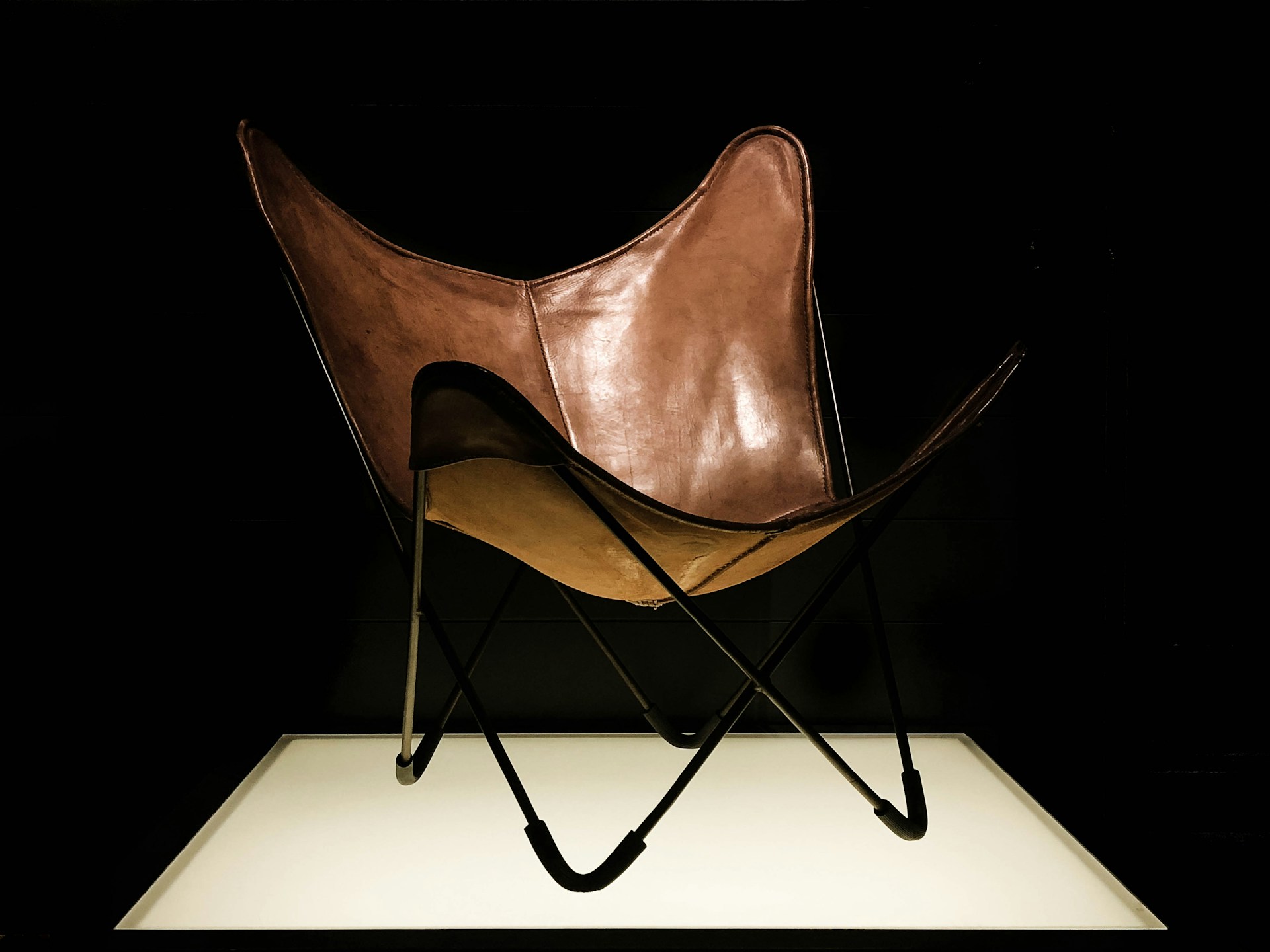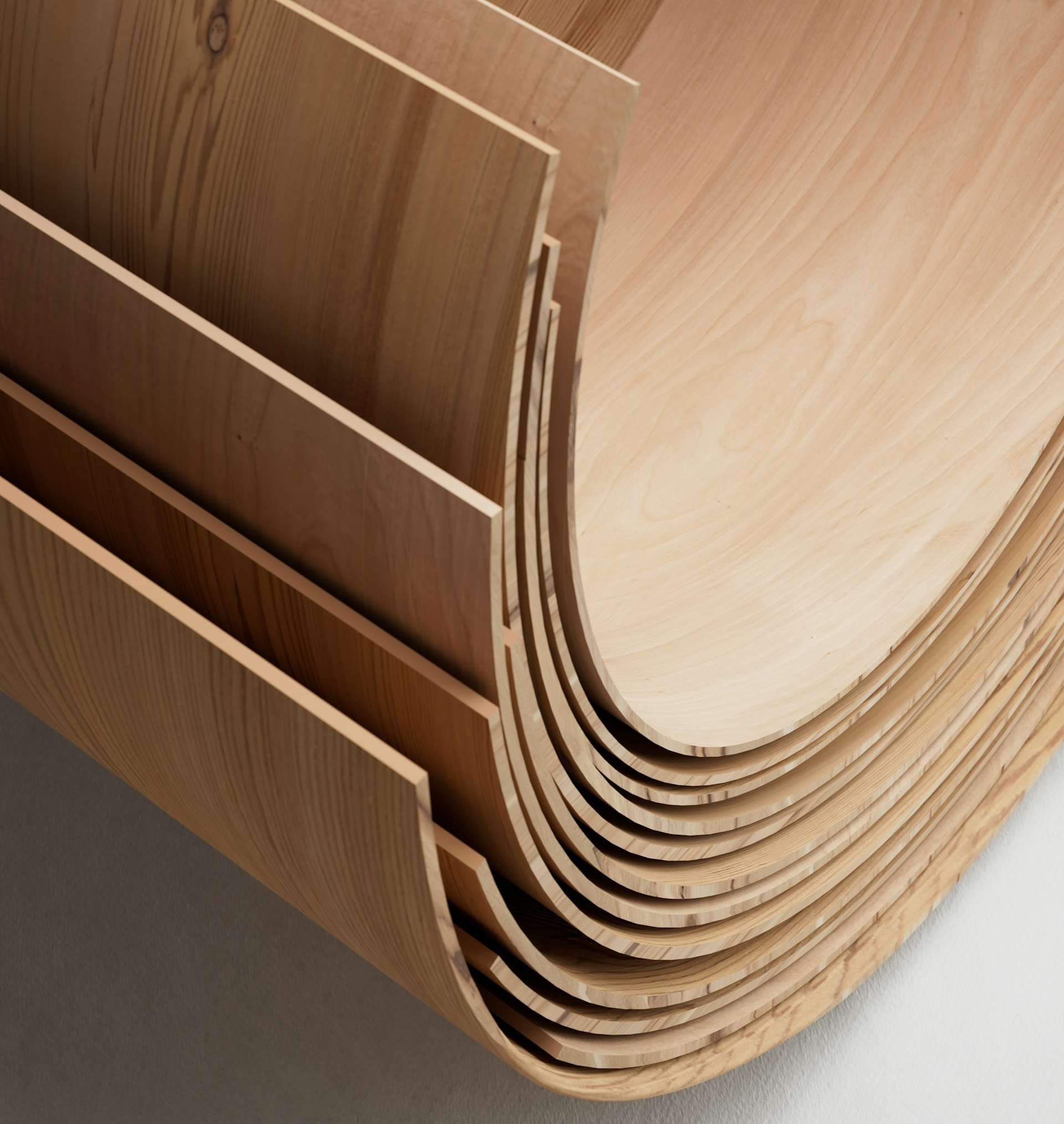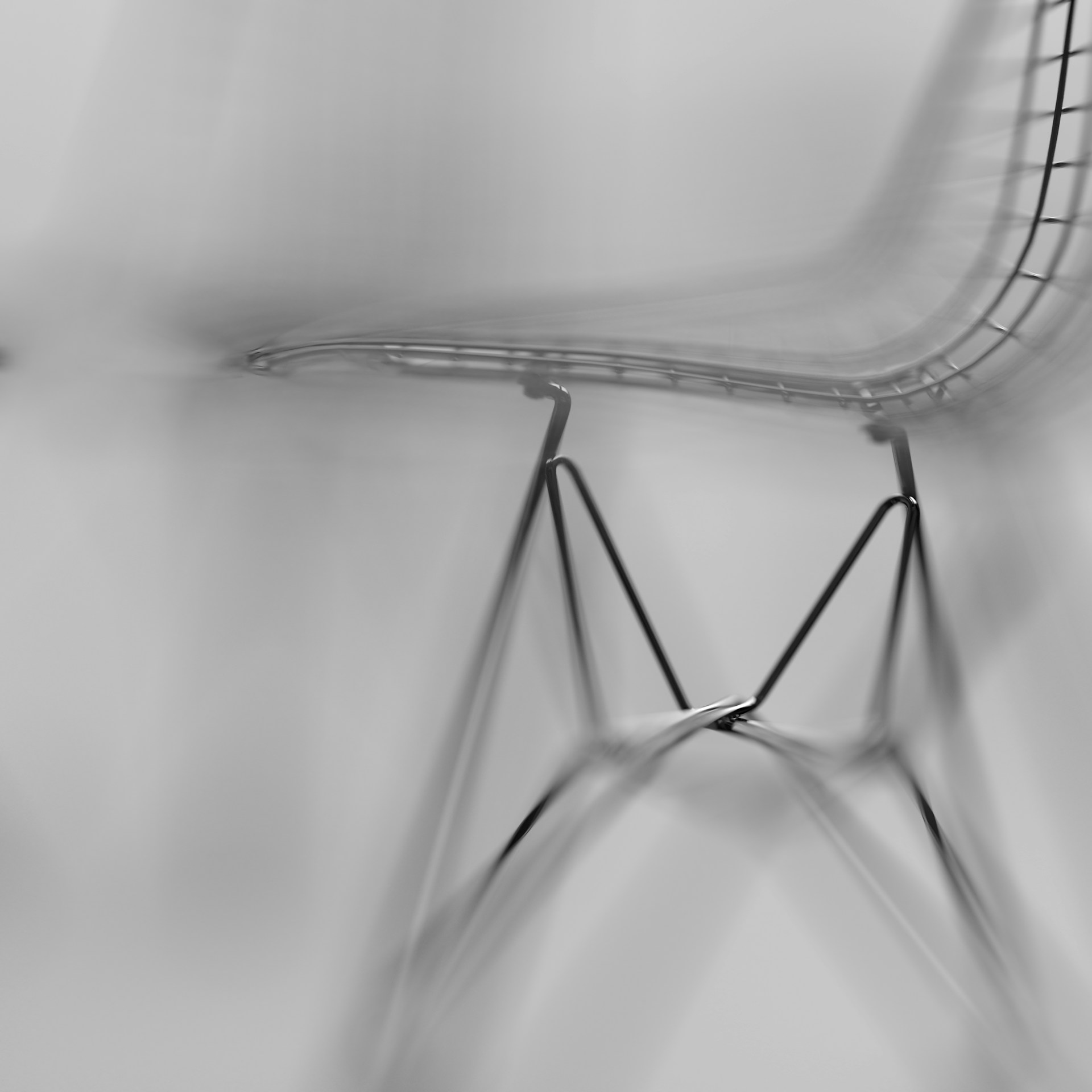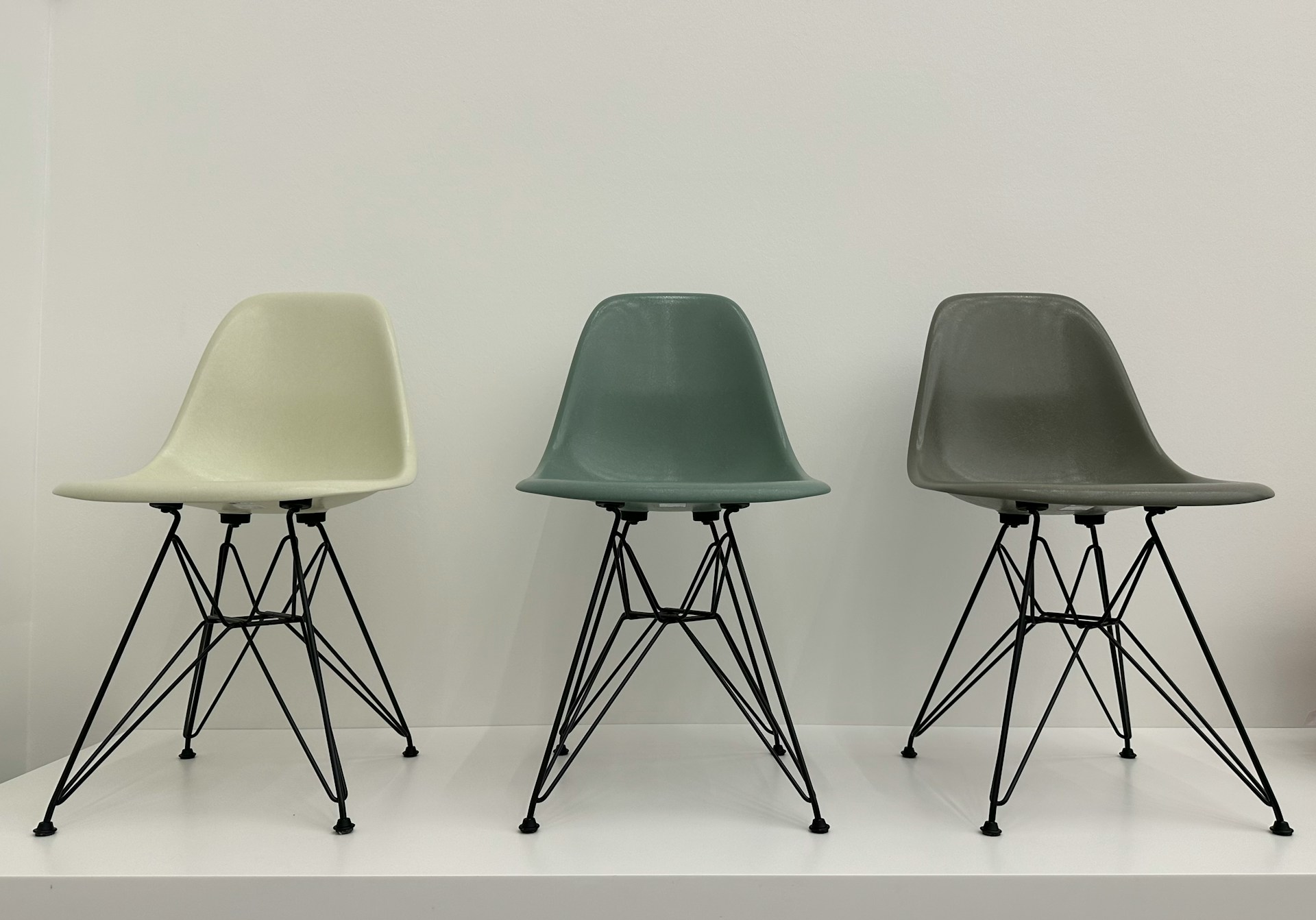How Plywood and Plastic Became Luxury: A Mid-Century Story

In 1946, furniture was made of wood and fabric, the way God and Victorian England intended. By 1956, Americans were sitting on molded fiberglass shells, bent plywood that looked like sculpture, and chairs made entirely of wire that somehow cost more than your car. The materials revolution wasn't just aesthetic rebellion - it was designers realizing they could steal from bombers, telephone poles, and boat hulls to make furniture that looked like it came from space. They were right about everything except how much people would pay for it seventy years later.
The Eames figured out that the plywood they'd been developing for military leg splints could cradle a human spine better than any amount of traditional upholstery. Harry Bertoia looked at industrial wire mesh and saw a chair that was "mainly air." Eero Saarinen took fiberglass from wartime radar domes and turned it into the Womb chair, because apparently that's what you do when traditional materials bore you. These weren't furniture makers. They were material scientists with design degrees, and they permanently broke the furniture industry's brain.
Plywood: The Bent Reality Nobody Expected

Before the Eameses, plywood was what you used for subflooring or shipping crates. It was cheap, ugly, and prone to delamination - essentially tree-flavored millefeuille that fell apart when wet. Then Charles and Ray spent four years figuring out how to bend it in three dimensions using heat, pressure, and a modified machine originally designed for making aircraft parts. The result was the 1946 DCW (Dining Chair Wood), which looked like someone had melted wood and let it cool into the shape of comfort.
The magic was in the layers. Five, seven, or nine sheets of veneer, each grain running perpendicular to the last, glued with resin that cost more per gallon than champagne. The curve wasn't aesthetic - it was structural. A flat piece of plywood that would snap under 200 pounds could hold 500 pounds when properly curved. The same principle that makes an egg impossible to crush from the ends made these chairs essentially indestructible. Original Eames plywood chairs from 1946 still function perfectly today, while traditional chairs from the same era have been reglued seventeen times.
The manufacturing process was insane. Each chair required custom molds that cost thousands to produce. The wood had to be steamed, bent, pressed, and held for exactly the right amount of time - too long and it would crack, too short and it would spring back. The failure rate in early production hit 60%. Herman Miller kept making them anyway because they knew they were watching furniture evolve in real time.
Fiberglass: Space-Age Optimism in Shell Form
Fiberglass furniture happened because Charles Eames entered a Museum of Modern Art competition in 1948 with designs that were literally impossible to manufacture. The chairs he designed required a material that could be molded into compound curves, was lighter than wood, stronger than steel by weight, and could be mass-produced. That material didn't exist for furniture yet. So they invented it. Saarinen's womb chair engineering demonstrated how fiberglass could create furniture that adapted to multiple sitting positions through material properties alone. Arne Jacobsen used similar molded foam techniques for the Egg Chair, though he switched from styrofoam to polyurethane foam to achieve the necessary strength and flexibility.
The process involved laying glass fibers into a mold, saturating them with polyester resin, and curing the whole thing into a shape that would have required master craftsmen weeks to achieve in wood. Each shell weighed eight pounds but could support 350. The material was waterproof, fadeproof, and essentially maintenance-free. It was also giving factory workers respiratory problems and shedding microscopic glass fibers into people's homes, but nobody figured that out until the 1980s.
Original fiberglass production ran from 1950 to 1984, when Herman Miller stopped because of health concerns. Those 34 years produced chairs that now sell for $800-3,000 each, depending on color and base configuration. The irony: modern "fiberglass" reproductions are usually polypropylene because actual fiberglass is too dangerous to manufacture. The plastic versions look identical but feel completely different - they flex where fiberglass stays rigid, they scratch where fiberglass chips, they age badly where fiberglass develops patina.
Wire Mesh: The Emperor's New Chair

Harry Bertoia's wire chairs were a scam that worked. He took industrial welding rod - the stuff used to reinforce concrete - bent it into a grid, and claimed it was furniture. The Diamond Chair (1952) was literally a sheet of wire mesh bent into a seat shape. It looked like it would collapse if you breathed on it. It could actually support 400 pounds because Bertoia understood that triangulated structures distribute force better than solid materials.
The manufacturing complexity was hidden in the simplicity. Each wire had to be bent to exact specifications, then welded at hundreds of intersection points. One bad weld and the entire structure would fail. The chrome plating process required multiple baths and precise timing - too little and it would rust, too much and it would flake. Original Bertoia pieces have welds so perfect they look machine-made. They weren't. Italian craftsmen spent hours on each chair, which is why a bunch of bent wire cost more than a leather sofa.
Wire furniture solved a problem nobody knew existed: visual weight. In small post-war homes, traditional furniture made rooms feel cramped. Wire chairs took up the same physical space but let light and sight lines pass through. They made rooms feel bigger without actually being smaller. Bertoia called it "space, form, and metal" but what he meant was "I figured out how to sell air for $500."
Molded Plastic: The Democratic Dream

Plastic was supposed to democratize good design. The Eameses genuinely believed that injection-molded chairs would make quality furniture accessible to everyone. They designed the single-shell plastic chair to be manufactured for about $3 per unit. Herman Miller sold them for $35 in 1950 (about $450 in 2026 dollars). George Nelson's clock designs followed similar thinking about mass production making good design accessible, though the market had other ideas. So much for democracy.
The plastic they used - polypropylene in most cases - was a revelation. It could be molded into shapes impossible with any other material, colored throughout so scratches didn't show, and manufactured in minutes rather than hours. It was also completely recyclable, though nobody cared about that in 1950. The molds cost $50,000-100,000 to create, but once you had them, you could produce thousands of identical chairs with minimal labor.
The problem was quality control. Early plastics aged badly - whites yellowed, colors faded, and the material became brittle. The difference between good plastic and bad plastic was invisible until five years later when chairs started cracking. Vintage plastic chairs from quality manufacturers now cost more than modern reproductions because survivors prove they were made correctly. It's survivor bias as investment strategy.
Aluminum: The Airplane Escape Plan
Aluminum furniture existed because of surplus airplane manufacturing capacity after World War II. Factories that had been making bomber fuselages needed something to do, and apparently making chairs from aircraft-grade aluminum seemed reasonable. The material was light, strong, and could be cast, extruded, or stamped into shapes that would be impossible with steel.
The Eames Aluminum Group (1958) used techniques taken directly from aerospace - the same stretch-forming process that made airplane wings made chair frames. The frames weighed twelve pounds but could support 300. The aluminum developed a patina over time that actually improved its appearance, unlike chrome which only got worse. Original aluminum pieces from the 1950s have a subtle grain pattern from the casting process that modern reproductions can't replicate because the original molds were destroyed.
The cost was astronomical. Aluminum required specialized equipment, skilled workers, and finishing processes that made each chair cost as much as a month's rent. But the chairs were essentially immortal. Aluminum doesn't rust, barely scratches, and can be recycled indefinitely without quality loss. Every Eames aluminum chair destroyed reduces the remaining supply forever, which is why prices keep climbing.
Leather Slings: Hammocks for Modernists

The leather sling chair was modernism's version of a dad joke - what if we just hung leather between two points and called it furniture? The Hardoy chair (1938), illegally copied so many times it became generic, was just leather draped over a metal frame. No structure, no support, just gravity and hope.
But the leather wasn't regular leather. It was thick-grain cowhide, 3-4mm thick, vegetable-tanned to remain flexible while strong. Each hide showed unique grain patterns, scars, and variations that made every chair slightly different. The leather would stretch exactly to your body over time, creating a personalized seat that couldn't be replicated. After five years, a leather sling chair became a portrait of its owner's sitting habits.
Modern versions use thin split leather or "leather-like" materials that miss the point entirely. They don't stretch properly, they don't age correctly, and they certainly don't develop that rich patina that makes forty-year-old originals look better than new ones. Original thick leather slings now cost $2,000-4,000. The copies that look identical cost $200. The difference becomes obvious after six months when the cheap leather starts cracking and the frame shows through.
The Persistence of Weird
These materials weren't chosen for novelty. Each solved specific problems that traditional materials couldn't. Plywood could be bent into ergonomic shapes. Fiberglass could be molded into shells. Wire could create structure from air. Plastic could be mass-produced. Aluminum could last forever. Leather could adapt to bodies. The weird materials made better chairs.
Today's reproductions use the same materials but rarely understand why. They copy the look without copying the logic. Modern plywood uses inferior glues that delaminate. Modern "fiberglass" is usually plastic. Modern wire chairs use thinner gauges that flex wrong. Modern bouclé looks period-appropriate but behaves nothing like original textiles. The materials were never arbitrary - they were answers to questions about how humans actually use furniture.
The market proves the materials mattered. Original pieces using original materials command 10-50 times the price of reproductions. It's not nostalgia or snobbery. An original Eames fiberglass shell feels different than a polypropylene one. Original Bertoia wire has a rigidity that reproductions can't match. The materials were the innovation. Everything else was just shape.